Grace Elliot's Blog: 'Familiar Felines.' , page 16
July 21, 2013
Performing for the King - a 'moving' experience at the Banqueting House
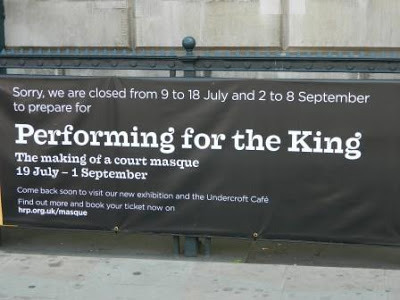 Last Thursday I was fortunate enough to preview a new exhibition ‘Performing for theKing’ at London’s Banqueting House, Whitehall. To be fair, ‘exhibition’ is too static a word to describe this event since there is movement and music, costumes to try on as well as period characters that mingle with the visitors. With deliberately subdued lighting to recreate the atmosphere of 17th century candlelight, this is anything but a walk-and-read display.
Last Thursday I was fortunate enough to preview a new exhibition ‘Performing for theKing’ at London’s Banqueting House, Whitehall. To be fair, ‘exhibition’ is too static a word to describe this event since there is movement and music, costumes to try on as well as period characters that mingle with the visitors. With deliberately subdued lighting to recreate the atmosphere of 17th century candlelight, this is anything but a walk-and-read display. 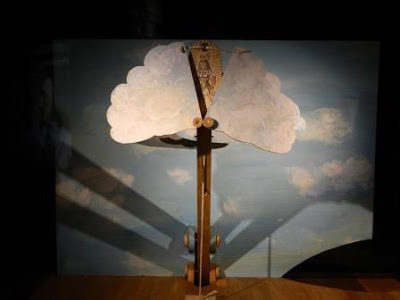 A model of Inigo Jones's contraption for lowering the queen
A model of Inigo Jones's contraption for lowering the queenout of a cloudThe aspect that most fired my imagination were Inigo Jones set designs and his use of early special effects. But first, a little background about ‘Performing for the King’ the creation of a court masque. The aim of the Banqueting House’s curator, Jane Spooner, is to give the visitor a sense of what went on behind the scenes at a 17th century masque and a taste of the atmosphere.
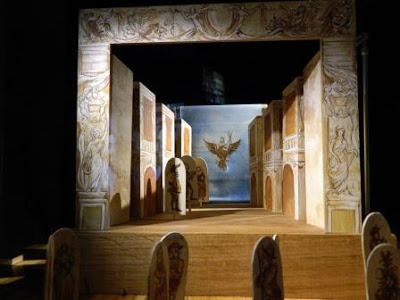 Jones' innovative use of newly 'discovered' perspective. To illustrate this Jane recreates part of the 1620 production of Tempe Restored. This masque (a play with music and dancing) was a sort of Stuart propaganda piece, pushing the message of the Stuart’s as a uniting monarchy, bringing peace to a troubled England and Scotland. The extravagant spectacle was designed to amaze and awe, but of course this carried a commensurate price tag. For the ordinary working man looking in from the outside, the cost of such masques must have rubbed salt into the wound of their day-to-day hardships.
Jones' innovative use of newly 'discovered' perspective. To illustrate this Jane recreates part of the 1620 production of Tempe Restored. This masque (a play with music and dancing) was a sort of Stuart propaganda piece, pushing the message of the Stuart’s as a uniting monarchy, bringing peace to a troubled England and Scotland. The extravagant spectacle was designed to amaze and awe, but of course this carried a commensurate price tag. For the ordinary working man looking in from the outside, the cost of such masques must have rubbed salt into the wound of their day-to-day hardships.  Another of Inigo Jones' set designs. One of the most eye-catching things about Tempe Restored was the innovative set design by Inigo Jones. For maximum impact the main players (the King and Queen playing the parts of Apollo and Diana) were to descend from the heavens in a cloud. To achieve this Ingio Jones created a piece of scenery worked by pulleys and powered by teams of strong men. Don’t forget this was in a time before hydraulics and engines, so any heavy lifting had to be done by muscle power. These moving elements were heavy and dangerous - and made a lot of noise which was disguised by playing loud music.
Another of Inigo Jones' set designs. One of the most eye-catching things about Tempe Restored was the innovative set design by Inigo Jones. For maximum impact the main players (the King and Queen playing the parts of Apollo and Diana) were to descend from the heavens in a cloud. To achieve this Ingio Jones created a piece of scenery worked by pulleys and powered by teams of strong men. Don’t forget this was in a time before hydraulics and engines, so any heavy lifting had to be done by muscle power. These moving elements were heavy and dangerous - and made a lot of noise which was disguised by playing loud music. 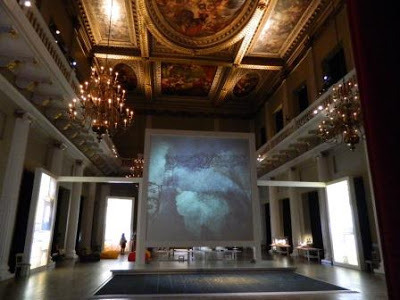 The screen before which the actors performInigo Jones used tricks of perspective, (a recent ‘invention’), as well as layering, lighting and masking to transform a 2-D stage into a 3-D drama. The clever people at the Banqueting House give the visitor a feel for these effects with Monty Pythonesque slides of scenery projected on the stage backdrop as the performance takes place.
The screen before which the actors performInigo Jones used tricks of perspective, (a recent ‘invention’), as well as layering, lighting and masking to transform a 2-D stage into a 3-D drama. The clever people at the Banqueting House give the visitor a feel for these effects with Monty Pythonesque slides of scenery projected on the stage backdrop as the performance takes place.
 The great man himself - Inigo Jones.
The great man himself - Inigo Jones.Meet him at Performing for the King!
To find out more click on Performing for the King - open from July 19th to September 1st 2013.
You can also chat to Inigo Jones himself on Twitter – simply tweet @ask_inigo and include a hashtag #man #woman #boy or #girl – to enrol yourself a character in the masque.
Once again, I’d like to extend my thanks to the Historic Royal Palaces organisation, and especially John Shevlin, for inviting me to this preview.
 Even I got into the spirit of things and tried on a ruff!
Even I got into the spirit of things and tried on a ruff!
Published on July 21, 2013 13:27
July 17, 2013
Line of Kings: the Wooden Horses
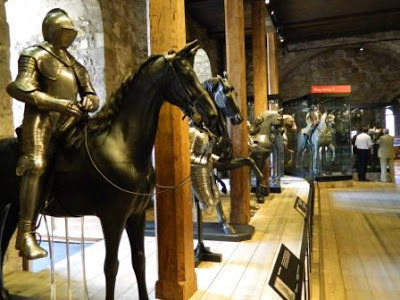
Last week I was fortunate to a preview the latest 'Line of Kings' exhibition at the Tower of London [see Line of Kings: the Oldest Exhibition in the World ]. Against a clear blue sky the White Tower looked stunning, the perfect setting to set the mood for this historic attraction.
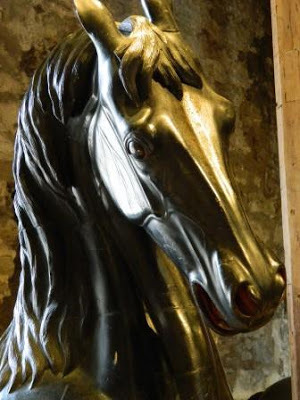
In this exhibition you will see suits of armour, including two worn by King Henry VIII, as well as life-sized horses, carved in the 1690's to display equine armour. For me it is these figures that steal the show. Because of their great age, over 300 years old, these horses are now too fragile to support the weight of armour they were originally intended to carry, but in their own right they are beautiful sculptures.
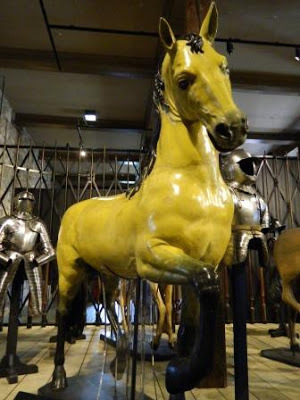
The poses of the horses are striking and a wonderfully insightful blog post on the significance of their stance can be found on here, on the 'History Needs You' blog. Be it artist or carpenter, it is obvious that whoever crafted these life-sized creatures had a wonderful empathy with the equine species. Prancing and firy, noble and elegant, you can read the respect of sculptor for subject in every vein and sinew. Indeed, the figures are so detailed that each model has horse shoes!
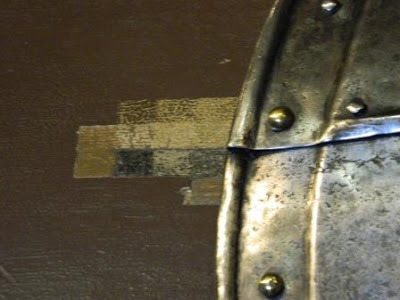 Detail showing the different paint finishes on the wooden horses
Detail showing the different paint finishes on the wooden horses(Wooden horse to the left of the photo, armour to the right) Endoscopy has given a fascinating insight into how these models were crafted. Each horse was made from wooden planking (they are hollow) and assembled with traditional carpentry techniques. If you look hard you can see the joins and wooden pins.
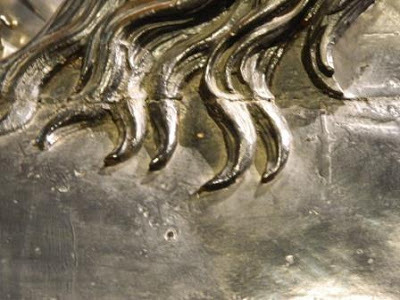 A detail showing the joins and a pin used to assemble the sculptures.Over the centuries each horse has been repainted multiple times. If you look carefully you can see a small area on some of the horses (on their flank, about halfway down) made up of postage-stamp sized areas of differing colours. This is were conservationists have painstakingly removed layer upon layer of paint to reveal the previous liveries.
A detail showing the joins and a pin used to assemble the sculptures.Over the centuries each horse has been repainted multiple times. If you look carefully you can see a small area on some of the horses (on their flank, about halfway down) made up of postage-stamp sized areas of differing colours. This is were conservationists have painstakingly removed layer upon layer of paint to reveal the previous liveries. 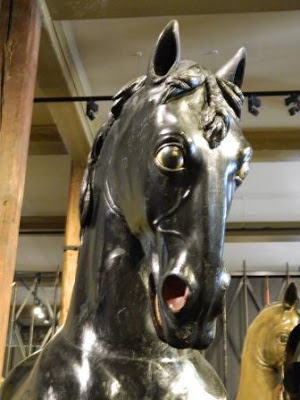 The horse, commissioned in 1685, used to display the model
The horse, commissioned in 1685, used to display the modelof King Henry VIII in armour. Unmarked and standing unassumingly amongst the rest are two horses of special significance. One is a black horse with rolling eyes and flared nostrils - this figure was the first commissioned to carry a model of King Henry VIII in his armour. The second is a prancing dun coloured horse that is a shade shorter than the others. It is suspected that this may have been carved by a man with the striking name of Grinling Gibbons.
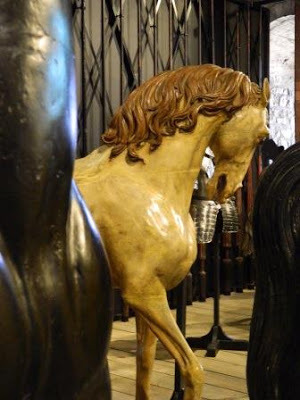 Was this horse carved by Grinling Gibbons?Grinling was a sculptor and woodworker whose catalogue includes carvings at St Paul's Cathedral, Hampton Court Palace and Blenheim Palace. Records exist showing the Grinling was paid forty pounds for a carving of Charles I and a horse. Later sculptors were paid half this amount.
Was this horse carved by Grinling Gibbons?Grinling was a sculptor and woodworker whose catalogue includes carvings at St Paul's Cathedral, Hampton Court Palace and Blenheim Palace. Records exist showing the Grinling was paid forty pounds for a carving of Charles I and a horse. Later sculptors were paid half this amount.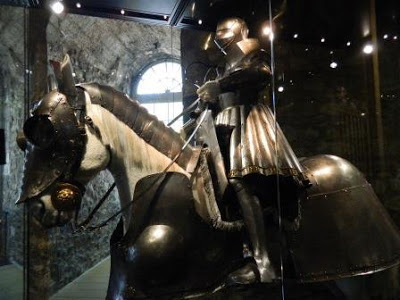 This horse is the cuckoo in the nest - Why?
This horse is the cuckoo in the nest - Why?Because it was made just a couple of years ago in order to carry the weight of
Henry VIII's armour.Some of the other wooden wonders on show at the Line of Kings include wooden carvings (from the late 17th century) in the form of the likenesses of monarchs, including Henry VIII and Charles I.
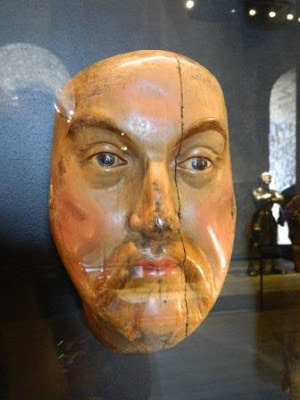 Carved in wood - the likeness of King Henry VIII-
Carved in wood - the likeness of King Henry VIII- part of an exhibition created 300 years ago
I would like to thank the lovely people at the Historic Royal Palaces, and John Shevlin in particular, for inviting an ordinary blogger to a preview of this wonderful exhibition. For those wishing to visit the Line of Kings, entry is free, included as part of the admission fee to the Tower of London.
Published on July 17, 2013 01:33
July 16, 2013
Line of Kings: The Oldest Exhibition in the World
Q: How long has the world’s oldest visitor attraction been on show?
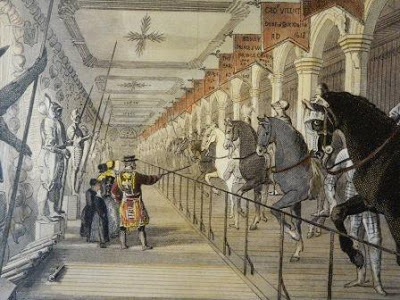 The Line of Kings A: An amazing 350 years – and the attraction is the Tower of London’s evocative ‘
Line of Kings’
exhibition. But just in case you are thinking the exhibits might be a bit dusty by now – let me assure you that the latest incarnation of this wonderful display is anything but dull!
The Line of Kings A: An amazing 350 years – and the attraction is the Tower of London’s evocative ‘
Line of Kings’
exhibition. But just in case you are thinking the exhibits might be a bit dusty by now – let me assure you that the latest incarnation of this wonderful display is anything but dull!
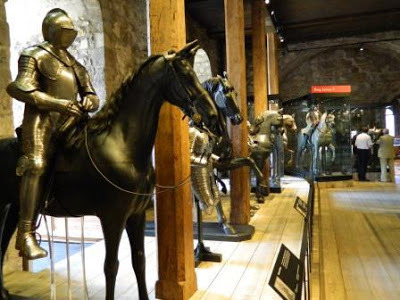
In the 17thcentury the aim of the attraction was to display the king’s armour and weapons, and remind subjects of the power of the crown. This latest take on historical armaments has added interest for today's visitor with a display of magnificent, life-sized wooden horses. These horses, carved in the 1690's, were designed as mounts suitable to showcase a king's armour, and in the modern day make breath-taking sculptures in their own right.
 The White Tower -
The White Tower - at the Tower of LondonSet in the historic White Tower, the very first ‘ Line of Kings’ display coincided with the restoration of the monarchy in 1660. The exhibition of royal armour was open to the public and was more concerned with pomp than historical accuracy. For instance, William the Conqueror’s armour was exhibited - despite it being in a style not designed until several hundred years later.
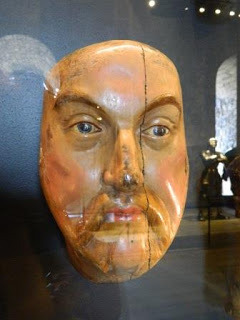 Carved wooden likeness of Henry VIII-
Carved wooden likeness of Henry VIII- created the late 1690'sSomewhat ironically, when William’s armour was removed from display in 1826 (because of historical inaccuracy), the suit was then reassigned to another nobleman! That said, it seems early visitors were not unaware of the liberties being taken with history if the account below is anything to go by: “As we gently mov’d along and viewed the princely scarecrows, he [the guide] told us to whom each suit of armour belong originally, adding some memorandums out of history…some true some false, supplying that with invention which he wanted in memory.”Ned Ward- visiting the Tower of London in 1699
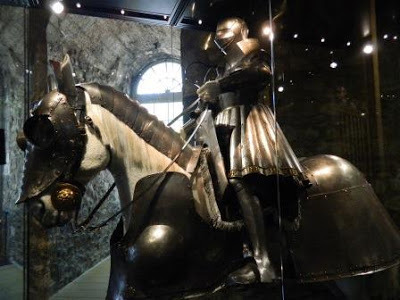 King Henry VIII armour on displayThe current ‘Line of Kings’ exhibition is now open at the Tower of London. Armour worn by Henry VIII and Charles I (amongst other royals) is on display, but the highlight of my visit and personal favourites are the gorgeously carved wooden artefacts in the form of life-sized prancing horses. [More about the horses in my next post]
King Henry VIII armour on displayThe current ‘Line of Kings’ exhibition is now open at the Tower of London. Armour worn by Henry VIII and Charles I (amongst other royals) is on display, but the highlight of my visit and personal favourites are the gorgeously carved wooden artefacts in the form of life-sized prancing horses. [More about the horses in my next post]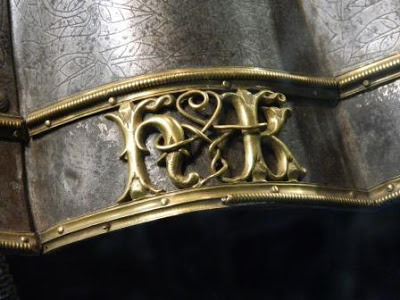 Detail from Henry VIII's armourAs well as those fabulous horses there is an eerie cabinet displaying the carved likenesses of kings’ heads and hands. To whet your appetite further, below is a photo of the wooden horse made to display King Henry VIII’s armour in a late 17th century display.
Detail from Henry VIII's armourAs well as those fabulous horses there is an eerie cabinet displaying the carved likenesses of kings’ heads and hands. To whet your appetite further, below is a photo of the wooden horse made to display King Henry VIII’s armour in a late 17th century display.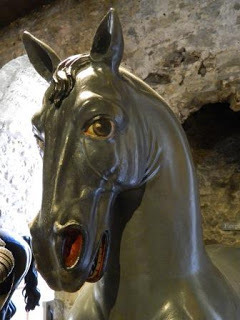 The original horse created to display
The original horse created to displayKing Henry VIII in his armour
Entry to the Line of Kings exhibition is included as part of the entrance fee to the Tower of London.
#LineofKings
Published on July 16, 2013 00:56
July 14, 2013
England's Last Revolution
Guest post by REGAN WALKER
I'm delighted to welcome author, Regan Walker, to my blog. As a writer, Regan has followed a similar path to myself: she wrote stories as a child but the serious business of making a living intervened - in Regan's case she entered the legal profession. But true calling wins out in the end and now Regan writes historical romance that often involve a demanding Prince Regent who thinks of his subjects as his private talent pool.
Regan lives in San Diego with her golden retriever, Link [what a fantastic name!] whom she says inspires her every day to relax and smell the roses.
 Welcome! Regan WalkerSo without further ado, here is Regan's post!
Welcome! Regan WalkerSo without further ado, here is Regan's post!
ENGLAND'S LAST REVOLUTION – When Mere Villagers Fought “Against the Wind”
On June 9, 1817, a group of village men from Pentrich in Derbyshire, England rose in rebellion against the Crown. Dubbed “the Last Revolution in England,” it might have more accurately been called a government-inspired provocation to action, designed to justify repression. Why did the villages fight “against the wind” that was the power of England?
After the war with France ended in 1814, England suffered from great social, economic and political problems. Many of the major issues were the direct result of the war, but others were the necessary product of the changes occurring throughout society. The discontent and the distress in the lives of the common people culminated in the series of events between 1811-1819, including the Pentrich Rebellion of 1817, which is the backdrop for my historical romance novel, Against the Wind.
 Pentrich Revolution plaque.
Pentrich Revolution plaque.
The uprising in the Midlands in 1817 was just what the leaders of the British government needed to justify sending a strong signal to the masses that no rebellion, such as occurred in the French Revolution, would be tolerated in England. The hundreds of villagers who rose up with the pikes and crude weapons on that day in June two hundred years ago were ignorant of the true fact—that the government itself was behind their actions.
The year 1817 began with a rally held in London in January, perhaps inspired by the political clubs that advocated the vote for all men. The mood of the masses was rebellious and ended with stones being thrown at the Prince Regent’s carriage as he left Parliament. While the Prince wasn’t harmed, with memories of the French Revolution still vivid in their minds, and the political clubs becoming more and more popular, especially in the Midlands and the North, the House of Lords adopted aspate of laws designed to control the stirrings of rebellion, including the suspension of Habeas Corpus, and the infamous Gagging Acts. All public meetings were forbidden, except under license from local magistrates. Pubs and coffee houses, as especially notorious places for radical gatherings, were covered by the Acts. Sedition, that is to say opposition to the government, whether by speech or written word, was to be severely punished.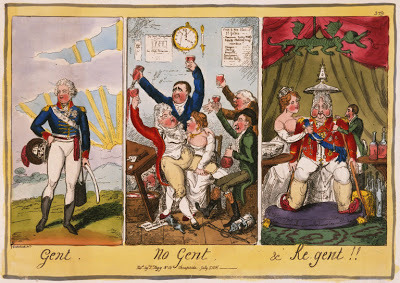 Gent....No Gent....Re gent!!
Gent....No Gent....Re gent!!
In March, there was a protest by thousands of depressed Manchester workers. With a view to descending on London to petition the Prince Regent to do something to relieve their economic depression, they marched peacefully carrying blankets to sleep in. Thus, it became known as the March of the Blanketeers. It rained violently on the day the march began. As five hundred of the menmarched towards Derby, they encountered masses of troops at the Hanging Bridge over the River Dove at Ashbourne. Most of the Blanketeers were turned away, but twenty-five were arrested. Only a few got to Derby and only one marcher reached London to present his petition. However, the Manchester expression of discontent served to keep alive the government’s fear of revolution.
Concerned about the growing unrest, Lord Sidmouth, the Home Secretary sent spies throughout England, including the Midlands, to keep watch on the “centers of discontent.” Since these spies were informers paid by results, they quickly became agents provocateur, stirring rebellion where there was none so they would be paid. Among the spies was one William Richards, better known as William Oliver, or “Oliver the spy,” who incited open rebellion in the Midlands. He is one of the characters in my novel.
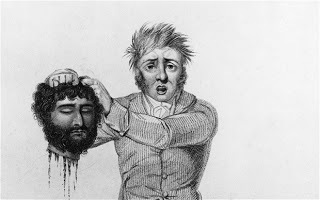 The head of Jeremiah Brandreth - one of the ringleaders
The head of Jeremiah Brandreth - one of the ringleaders
of the Pentrich uprising.Oliver traveled to Pentrich in Derbyshire, disguised as a depressed worker (he had previously been in Fleet Prison), encouraging the villagers to armed rebellion. He assured them there were thousands in London ready to join them in rising against the Crown. The villagers, in their ignorance, believed him. They were simple men who thought they were joining a great cause for democracy where every man would have a vote. They would soon learn they were wrong.
At the same time that Oliver was making arrangements with the villagers for an armed march to air their discontent, he informed the local militia of the planned uprising, even giving them the date. Due to Oliver’s lies, the hundreds who marched on that rainy night in June had no idea they stood not a chance of accomplishing their objective. When the dawn came, the men faced a regiment of the King’s Own Dragoons and were soon scattered or captured.
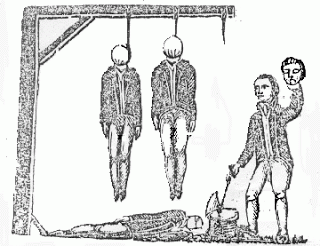 A gruesome depiction of the execution of the ringleaders.Notwithstanding the circumstances of the uprising and the involvement of the English government, the powers in London decided to make an example of the rebels. Forty-five men were tried for high treason. Three were hanged, including Jeremiah Brandreth, Isaac Ludlam and William Turner, the “ringleaders”—all characters in my novel. Fourteen were sentenced to transportation to Australia, including one young man of whom my heroine was quite fond.
A gruesome depiction of the execution of the ringleaders.Notwithstanding the circumstances of the uprising and the involvement of the English government, the powers in London decided to make an example of the rebels. Forty-five men were tried for high treason. Three were hanged, including Jeremiah Brandreth, Isaac Ludlam and William Turner, the “ringleaders”—all characters in my novel. Fourteen were sentenced to transportation to Australia, including one young man of whom my heroine was quite fond.
Years after the events, in a letter written in 1831, Lord Melbourne, a former Home Secretary, recalled that there was "much reason to suspect that the rising in Derbyshire...was stimulated, if not produced, by the artifices of Oliver, a spy employed by the Government of that day.”
My story begins in London where a young noblewoman flees a fate worse than death and runs unknowingly into the arms of a spy for the Crown.
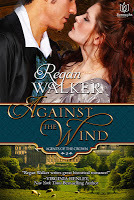 Click for link
Click for link
Excerpt: AGAINST THE WINDChapter 1
London, April 1817
She is dead.
Katherine, Lady Egerton, stared at the still form lying on the bed. Beloved sister, friend of the heart…Anne was gone. One minute she was struggling for breath, the next she lay silent and still. The only person in the world Kit loved more than life had left her. They are all gone now. The sudden solitude tore at her heart. Kit smiled sadly, gazing through eyes filled with tears at the frail body lying before her. The brown mouse. Anne’s name for herself. Delicate even as a child, she had not long survived her marriage to the cruel Earl of Rutledge. Kit knelt at her sister’s bedside, assailed by grief and guilt, and reached for Anne’s hand. Could she have done more to save her sister from the dread disease? Could she have done more to protect Anne from the heartless man who was her husband? Pale in death, Anne was still beautiful. Kit had often sketched that heart-shaped face. Not a mouse, but a much-loved sister with a kind, unselfish heart. Kit had seen the end coming in the last few months, months through which she’d faithfully cared for Anne. The coughs that wracked her sister’s slight frame had grown worse as Anne seemed to fade before Kit’s eyes. Kit knew she was losing her even as she willed that weak body to heal. The physician said he could do nothing; each time he left shaking his head and telling Kit to make “the poor girl” comfortable as best she could. Kit had tried to save Anne, doing the only thing she knew by giving her syrup of horehound and honey. But such a small measure was not enough. Then, too, her sister had seemed to welcome death. Suddenly, the room grew cold. Kit felt his presence, a looming evil behind her. She took a deep breath and summoned her strength. “Leave her and come to me.” Rutledge’s tone was harsh and demanding. Kit had no need to see him to know his face would be twisted in an odious scowl, his lips drawn taut. “It is time.” “I must see to my sister.” “You need do nothing. I have arranged for the burial. Come away now.” Kit knew what he wanted, for she had seen the lust in his dark eyes. What at first had been sideways glances became leers and unwanted touches. Though she’d lived in his home since the death of her husband the baron, Kit had avoided the earl, rarely leaving her sister’s bedside. She had been thinking of a way to escape, but her exhaustion in caring for Anne these last days left those plans incomplete. With meager funds, her options were few. When she failed to rise at the earl’s direction, his hand roughly gripped her shoulder. She stiffened at the pain of his fingers digging into her skin. “I have waited long for you, Katherine, enduring that mockery of a marriage to your sister while all the while it was you I wanted, you I was promised. Now I shall have what is mine.” “No!” She rose swiftly, stepping back as she turned to face him. Revulsion rose in her throat. What did he mean by those words? She never had been promised to him! His smirk transfigured what many thought of as a handsome face. Hadn’t Anne at first been fooled by his aristocratic features and wavy brown hair? One had only to look closely to see his nature reflected in those thin lips and narrow eyes now focused on Kit. A deep furrow between his brows bore witness to his long having insisted upon having his way. When Kit sketched him, it had been as an attacking hawk. “What will you do?” he asked smugly. “Where will you go, m’dear? You are alone and without funds. I am the one who has provided food and shelter for both you and your weak sister, though I wanted only you. You are mine, Katherine, and I will have you.” Terror seized her. Cornered, her eyes darted about like an animal snared in a trap. His tall figure blocked the door to the corridor; the only way out led through his adjacent bedchamber. She fled toward it. She hastened into the room as he stalked after her, knowing she had but seconds, and her eyes searched for a weapon, something to hold him at bay. At the side of the fireplace were tools, short bars of iron that could fend off a man. But could she reach them in time? He lunged for her just as she ran toward the fireplace. His body collided with hers, and she fell upon the wooden floor with a thud. Pain shot through her hip. His body crashed down upon hers, forcing the air from her lungs. She gasped a breath just as his mouth crushed her lips, ruthlessly claiming dominance. Tearing away, she pushed against his shoulders with all her might, but his greater strength held her pinned to the floor. His hand gripped one breast and squeezed. She winced at the pain, but that was quickly forgotten the moment a greater terror seized her: His aroused flesh pressed into her belly. Violently she struggled, but to no avail. His wet lips slid down her throat to her heaving chest as his fingers gripped the top of her gown and yanked at the silk. Kit heard the fabric tear as he ripped her gown and the top of her chemise, and she felt the cool air on her naked breasts. Frantic, she mustered strength she did not know she had. Twisting in his grasp, she reached for the iron poker now a mere foot away. His mouth latched onto her breast where he voraciously sucked a nipple. Lost in his lust, he did not see her grasp the length of iron, raise it above him and bring it crashing down on his head. Stunned by the blow, he raised up, his eyes glazed. Kit let the bar fall again, this time with greater force. Blood spattered her chest and face as his body went limp. He slumped atop her. Kit’s heart pounded in her chest like a bird’s wing beating against a cage. Frantically she shoved his face from her breast and rolled his body to the floor. Unsteady at first, her breath coming in pants, Kit rose and looked down at the crumpled form lying before her, every nerve on edge as she gazed into that evil face, now deathly pale. Blood oozed from a gash in the earl’s left temple. There was no sign of life, no movement. I have killed him! Fear choked off her breath as she wiped blood from her face with a sleeve, and with one last look toward her sister’s bedchamber she raced from the room. Footsteps sounded down the hall. Alarmed at the prospect of encountering one of the earl’s servants who would summon a constable, Kit knew she must find a place to hide, and there was nowhere to hide in the house. Quietly stealing into her bedchamber, she grabbed her cloak and reticule, stuffing inside it the one piece of her jewelry that could be sold to sustain her, and fled the dwelling. Out on the street, she paused to draw her cloak tightly around her, desperate to cover her torn and bloody gown. Where could she go? Who would shelter her in the state she was in, given the deed she had done? Only one name came to her. Willow House.
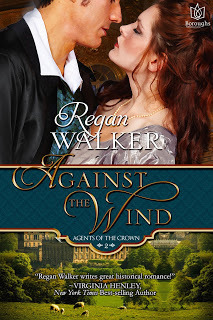 Click for linkLearn more about Regan Walker here:
Click for linkLearn more about Regan Walker here:
Author website: http://www.reganwalkerauthor.com/
Regan’s Romance Reviews blog: http://reganromancereview.blogspot.com/
Twitter: @RegansReview (https://twitter.com/RegansReview)
Facebook: http://www.facebook.com/regan.walker.104
Goodreads: http://www.goodreads.com/author/show/6450403.Regan_Walker
I'm delighted to welcome author, Regan Walker, to my blog. As a writer, Regan has followed a similar path to myself: she wrote stories as a child but the serious business of making a living intervened - in Regan's case she entered the legal profession. But true calling wins out in the end and now Regan writes historical romance that often involve a demanding Prince Regent who thinks of his subjects as his private talent pool.
Regan lives in San Diego with her golden retriever, Link [what a fantastic name!] whom she says inspires her every day to relax and smell the roses.
 Welcome! Regan WalkerSo without further ado, here is Regan's post!
Welcome! Regan WalkerSo without further ado, here is Regan's post! ENGLAND'S LAST REVOLUTION – When Mere Villagers Fought “Against the Wind”
On June 9, 1817, a group of village men from Pentrich in Derbyshire, England rose in rebellion against the Crown. Dubbed “the Last Revolution in England,” it might have more accurately been called a government-inspired provocation to action, designed to justify repression. Why did the villages fight “against the wind” that was the power of England?
After the war with France ended in 1814, England suffered from great social, economic and political problems. Many of the major issues were the direct result of the war, but others were the necessary product of the changes occurring throughout society. The discontent and the distress in the lives of the common people culminated in the series of events between 1811-1819, including the Pentrich Rebellion of 1817, which is the backdrop for my historical romance novel, Against the Wind.
 Pentrich Revolution plaque.
Pentrich Revolution plaque.The uprising in the Midlands in 1817 was just what the leaders of the British government needed to justify sending a strong signal to the masses that no rebellion, such as occurred in the French Revolution, would be tolerated in England. The hundreds of villagers who rose up with the pikes and crude weapons on that day in June two hundred years ago were ignorant of the true fact—that the government itself was behind their actions.
The year 1817 began with a rally held in London in January, perhaps inspired by the political clubs that advocated the vote for all men. The mood of the masses was rebellious and ended with stones being thrown at the Prince Regent’s carriage as he left Parliament. While the Prince wasn’t harmed, with memories of the French Revolution still vivid in their minds, and the political clubs becoming more and more popular, especially in the Midlands and the North, the House of Lords adopted aspate of laws designed to control the stirrings of rebellion, including the suspension of Habeas Corpus, and the infamous Gagging Acts. All public meetings were forbidden, except under license from local magistrates. Pubs and coffee houses, as especially notorious places for radical gatherings, were covered by the Acts. Sedition, that is to say opposition to the government, whether by speech or written word, was to be severely punished.
 Gent....No Gent....Re gent!!
Gent....No Gent....Re gent!!In March, there was a protest by thousands of depressed Manchester workers. With a view to descending on London to petition the Prince Regent to do something to relieve their economic depression, they marched peacefully carrying blankets to sleep in. Thus, it became known as the March of the Blanketeers. It rained violently on the day the march began. As five hundred of the menmarched towards Derby, they encountered masses of troops at the Hanging Bridge over the River Dove at Ashbourne. Most of the Blanketeers were turned away, but twenty-five were arrested. Only a few got to Derby and only one marcher reached London to present his petition. However, the Manchester expression of discontent served to keep alive the government’s fear of revolution.
Concerned about the growing unrest, Lord Sidmouth, the Home Secretary sent spies throughout England, including the Midlands, to keep watch on the “centers of discontent.” Since these spies were informers paid by results, they quickly became agents provocateur, stirring rebellion where there was none so they would be paid. Among the spies was one William Richards, better known as William Oliver, or “Oliver the spy,” who incited open rebellion in the Midlands. He is one of the characters in my novel.
 The head of Jeremiah Brandreth - one of the ringleaders
The head of Jeremiah Brandreth - one of the ringleaders of the Pentrich uprising.Oliver traveled to Pentrich in Derbyshire, disguised as a depressed worker (he had previously been in Fleet Prison), encouraging the villagers to armed rebellion. He assured them there were thousands in London ready to join them in rising against the Crown. The villagers, in their ignorance, believed him. They were simple men who thought they were joining a great cause for democracy where every man would have a vote. They would soon learn they were wrong.
At the same time that Oliver was making arrangements with the villagers for an armed march to air their discontent, he informed the local militia of the planned uprising, even giving them the date. Due to Oliver’s lies, the hundreds who marched on that rainy night in June had no idea they stood not a chance of accomplishing their objective. When the dawn came, the men faced a regiment of the King’s Own Dragoons and were soon scattered or captured.
 A gruesome depiction of the execution of the ringleaders.Notwithstanding the circumstances of the uprising and the involvement of the English government, the powers in London decided to make an example of the rebels. Forty-five men were tried for high treason. Three were hanged, including Jeremiah Brandreth, Isaac Ludlam and William Turner, the “ringleaders”—all characters in my novel. Fourteen were sentenced to transportation to Australia, including one young man of whom my heroine was quite fond.
A gruesome depiction of the execution of the ringleaders.Notwithstanding the circumstances of the uprising and the involvement of the English government, the powers in London decided to make an example of the rebels. Forty-five men were tried for high treason. Three were hanged, including Jeremiah Brandreth, Isaac Ludlam and William Turner, the “ringleaders”—all characters in my novel. Fourteen were sentenced to transportation to Australia, including one young man of whom my heroine was quite fond. Years after the events, in a letter written in 1831, Lord Melbourne, a former Home Secretary, recalled that there was "much reason to suspect that the rising in Derbyshire...was stimulated, if not produced, by the artifices of Oliver, a spy employed by the Government of that day.”
My story begins in London where a young noblewoman flees a fate worse than death and runs unknowingly into the arms of a spy for the Crown.
 Click for link
Click for link Excerpt: AGAINST THE WINDChapter 1
London, April 1817
She is dead.
Katherine, Lady Egerton, stared at the still form lying on the bed. Beloved sister, friend of the heart…Anne was gone. One minute she was struggling for breath, the next she lay silent and still. The only person in the world Kit loved more than life had left her. They are all gone now. The sudden solitude tore at her heart. Kit smiled sadly, gazing through eyes filled with tears at the frail body lying before her. The brown mouse. Anne’s name for herself. Delicate even as a child, she had not long survived her marriage to the cruel Earl of Rutledge. Kit knelt at her sister’s bedside, assailed by grief and guilt, and reached for Anne’s hand. Could she have done more to save her sister from the dread disease? Could she have done more to protect Anne from the heartless man who was her husband? Pale in death, Anne was still beautiful. Kit had often sketched that heart-shaped face. Not a mouse, but a much-loved sister with a kind, unselfish heart. Kit had seen the end coming in the last few months, months through which she’d faithfully cared for Anne. The coughs that wracked her sister’s slight frame had grown worse as Anne seemed to fade before Kit’s eyes. Kit knew she was losing her even as she willed that weak body to heal. The physician said he could do nothing; each time he left shaking his head and telling Kit to make “the poor girl” comfortable as best she could. Kit had tried to save Anne, doing the only thing she knew by giving her syrup of horehound and honey. But such a small measure was not enough. Then, too, her sister had seemed to welcome death. Suddenly, the room grew cold. Kit felt his presence, a looming evil behind her. She took a deep breath and summoned her strength. “Leave her and come to me.” Rutledge’s tone was harsh and demanding. Kit had no need to see him to know his face would be twisted in an odious scowl, his lips drawn taut. “It is time.” “I must see to my sister.” “You need do nothing. I have arranged for the burial. Come away now.” Kit knew what he wanted, for she had seen the lust in his dark eyes. What at first had been sideways glances became leers and unwanted touches. Though she’d lived in his home since the death of her husband the baron, Kit had avoided the earl, rarely leaving her sister’s bedside. She had been thinking of a way to escape, but her exhaustion in caring for Anne these last days left those plans incomplete. With meager funds, her options were few. When she failed to rise at the earl’s direction, his hand roughly gripped her shoulder. She stiffened at the pain of his fingers digging into her skin. “I have waited long for you, Katherine, enduring that mockery of a marriage to your sister while all the while it was you I wanted, you I was promised. Now I shall have what is mine.” “No!” She rose swiftly, stepping back as she turned to face him. Revulsion rose in her throat. What did he mean by those words? She never had been promised to him! His smirk transfigured what many thought of as a handsome face. Hadn’t Anne at first been fooled by his aristocratic features and wavy brown hair? One had only to look closely to see his nature reflected in those thin lips and narrow eyes now focused on Kit. A deep furrow between his brows bore witness to his long having insisted upon having his way. When Kit sketched him, it had been as an attacking hawk. “What will you do?” he asked smugly. “Where will you go, m’dear? You are alone and without funds. I am the one who has provided food and shelter for both you and your weak sister, though I wanted only you. You are mine, Katherine, and I will have you.” Terror seized her. Cornered, her eyes darted about like an animal snared in a trap. His tall figure blocked the door to the corridor; the only way out led through his adjacent bedchamber. She fled toward it. She hastened into the room as he stalked after her, knowing she had but seconds, and her eyes searched for a weapon, something to hold him at bay. At the side of the fireplace were tools, short bars of iron that could fend off a man. But could she reach them in time? He lunged for her just as she ran toward the fireplace. His body collided with hers, and she fell upon the wooden floor with a thud. Pain shot through her hip. His body crashed down upon hers, forcing the air from her lungs. She gasped a breath just as his mouth crushed her lips, ruthlessly claiming dominance. Tearing away, she pushed against his shoulders with all her might, but his greater strength held her pinned to the floor. His hand gripped one breast and squeezed. She winced at the pain, but that was quickly forgotten the moment a greater terror seized her: His aroused flesh pressed into her belly. Violently she struggled, but to no avail. His wet lips slid down her throat to her heaving chest as his fingers gripped the top of her gown and yanked at the silk. Kit heard the fabric tear as he ripped her gown and the top of her chemise, and she felt the cool air on her naked breasts. Frantic, she mustered strength she did not know she had. Twisting in his grasp, she reached for the iron poker now a mere foot away. His mouth latched onto her breast where he voraciously sucked a nipple. Lost in his lust, he did not see her grasp the length of iron, raise it above him and bring it crashing down on his head. Stunned by the blow, he raised up, his eyes glazed. Kit let the bar fall again, this time with greater force. Blood spattered her chest and face as his body went limp. He slumped atop her. Kit’s heart pounded in her chest like a bird’s wing beating against a cage. Frantically she shoved his face from her breast and rolled his body to the floor. Unsteady at first, her breath coming in pants, Kit rose and looked down at the crumpled form lying before her, every nerve on edge as she gazed into that evil face, now deathly pale. Blood oozed from a gash in the earl’s left temple. There was no sign of life, no movement. I have killed him! Fear choked off her breath as she wiped blood from her face with a sleeve, and with one last look toward her sister’s bedchamber she raced from the room. Footsteps sounded down the hall. Alarmed at the prospect of encountering one of the earl’s servants who would summon a constable, Kit knew she must find a place to hide, and there was nowhere to hide in the house. Quietly stealing into her bedchamber, she grabbed her cloak and reticule, stuffing inside it the one piece of her jewelry that could be sold to sustain her, and fled the dwelling. Out on the street, she paused to draw her cloak tightly around her, desperate to cover her torn and bloody gown. Where could she go? Who would shelter her in the state she was in, given the deed she had done? Only one name came to her. Willow House.
 Click for linkLearn more about Regan Walker here:
Click for linkLearn more about Regan Walker here:Author website: http://www.reganwalkerauthor.com/
Regan’s Romance Reviews blog: http://reganromancereview.blogspot.com/
Twitter: @RegansReview (https://twitter.com/RegansReview)
Facebook: http://www.facebook.com/regan.walker.104
Goodreads: http://www.goodreads.com/author/show/6450403.Regan_Walker
Published on July 14, 2013 00:30
July 9, 2013
OUT NOW - Verity's Lie

Win a $30 Amazon voucher (or UK equivalent) see the end of this post for more details
Verity's Lie - #3 The Huntley Trilogy
Charles Huntley, Lord Ryevale, infamous rogue…and government agent.
In unsettled times, with England at war with France, Ryevale is assigned to covertly protect a politician’s daughter, Miss Verity Verrinder. To keep Verity under his watchful eye, Ryevale plots a campaign of seduction that no woman can resist– except it seems, Miss Verrinder. In order to gain her trust Ryevale enters Verity’s world of charity meetings and bookshops…where the unexpected happens and he falls in love with his charge.
When Lord Ryevale turns his bone-melting charms on her, Verity questions his lordship’s motivation. But with her controlling father abroad, Verity wishes to explore London and reluctantly accepts Ryevale’s companionship. As the compelling attraction between them strengthens, Verity is shattered to learn her instincts are correct after all – and Ryevale is not what he seems. If Lord Ryevale can lie, so can she… withdisastrous consequences.
 OUT NOW!
OUT NOW!Click for Amazon.com link Amazon .com http://amzn.to/13CxrN1 Amazon.uk http://amzn.to/12aEqI6
For a limited time both 'Eulogy's Secret' and 'Hope's Betrayal' are just 99 cents each.
COMPETITION TIME
Win a $30 Amazon voucher (or UK equivalent)
From Verity’s Lie take the first letter of the first word from each of the following chapters:
Chapter 4 Chapter 9
Chapter 10
Chapter 17
Rearrange these 4 letters to make a new word. Don’t forget you can use the ‘Go to’ link on your kindle to help you search! To enter, please email your answer (the 4 letter word) to grace.elliot@virginmedia.com
Put “VL Competition”as the title of your email. The winner will be contacted via email on 31 July 2013 and the winner’s name posted on Grace’s blog: Fall in Love with History

Published on July 09, 2013 07:59
July 3, 2013
Give a Dog a Bad Name
People have loved their pet dogs since the domestication of wolves took place in the Mesolithic era. But what can we learn about man’s relationship to dog from phrases and sayings from the past – the results may surprise you!
 DogA domesticated carnivorous mammal, Canis familiaris (or C. lupus familiaris), which typically has a long snout, an acute sense of smell, non-retractile claws, and a barking, howling, or whining voice, widely kept as a pet or for hunting, herding livestock, guarding, or other utilitarian purposes. [OED] Where does the word ‘dog’ come from? ‘Dog’ belongs in a group of word that are unique to the English language. These are a collection of animal nouns that end in -g , such as hog, pig, stag and …erhm…earwig! ‘Dog’ is used in olde English texts, but not as often as ‘hound’ – variations of which are found in many European countries ( Dutch – hond, German – hund. )
DogA domesticated carnivorous mammal, Canis familiaris (or C. lupus familiaris), which typically has a long snout, an acute sense of smell, non-retractile claws, and a barking, howling, or whining voice, widely kept as a pet or for hunting, herding livestock, guarding, or other utilitarian purposes. [OED] Where does the word ‘dog’ come from? ‘Dog’ belongs in a group of word that are unique to the English language. These are a collection of animal nouns that end in -g , such as hog, pig, stag and …erhm…earwig! ‘Dog’ is used in olde English texts, but not as often as ‘hound’ – variations of which are found in many European countries ( Dutch – hond, German – hund. ) 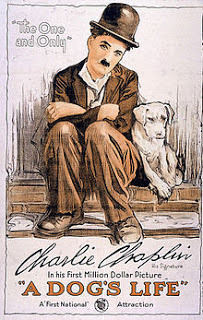 To ‘Cast Someone to the Dogs’Lapdogs were known prior to the 18th century, but largely regarded with distain. The proper place for a dog was as a working animal, hunting or guarding. The language used in the 17th century and earlier reflects the workman-like relationship of man to dog and the rough life the animal was expected to endure.
To ‘Cast Someone to the Dogs’Lapdogs were known prior to the 18th century, but largely regarded with distain. The proper place for a dog was as a working animal, hunting or guarding. The language used in the 17th century and earlier reflects the workman-like relationship of man to dog and the rough life the animal was expected to endure.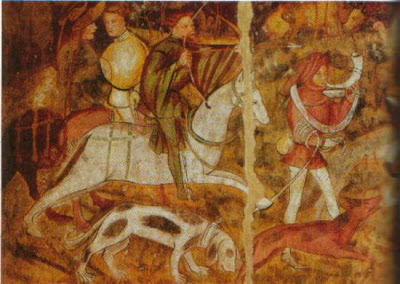 The proper use for a dog was as a working animal - as pictured here.To cast someone to the dogs (expression recorded in 1556) or go to the dogs (1619) was used to mean that you didn’t care what happened to that person. Dog eat dog (used from 1789) and unleash the dogs of war(Shakespeare’s Julius Caesar) – language denoting the savagery of dogs – a far cry from cuddly lapdogs! Likewise a medieval proverb about not waking a sleeping dog (a variant of which is still in modern use, let sleeping dogs lie) – meant to watch out for trouble if the dog was woken.A Hair of the Dog‘A hair of the dog’is in common parlance as meaning an alcoholic hangover cure - but surprisingly this saying actually originates from the mid-16th century and the fear of rabies. At a time when rabies was present in Britain, one suggested remedy to cure a bite from an infected dog, was to imbibe of ‘a hair of the dog that bit you.’ Just as with the hangover cure, it’s unlikely this helped.
The proper use for a dog was as a working animal - as pictured here.To cast someone to the dogs (expression recorded in 1556) or go to the dogs (1619) was used to mean that you didn’t care what happened to that person. Dog eat dog (used from 1789) and unleash the dogs of war(Shakespeare’s Julius Caesar) – language denoting the savagery of dogs – a far cry from cuddly lapdogs! Likewise a medieval proverb about not waking a sleeping dog (a variant of which is still in modern use, let sleeping dogs lie) – meant to watch out for trouble if the dog was woken.A Hair of the Dog‘A hair of the dog’is in common parlance as meaning an alcoholic hangover cure - but surprisingly this saying actually originates from the mid-16th century and the fear of rabies. At a time when rabies was present in Britain, one suggested remedy to cure a bite from an infected dog, was to imbibe of ‘a hair of the dog that bit you.’ Just as with the hangover cure, it’s unlikely this helped.  A Dog’s LifeThe majority of working dogs lived outdoors and although fed scraps, they also largely fended for themselves. The original intent of ‘a dog’s life’ was to imply a pitiful, miserable existence. The word dog was similarly used to imply something second-rate, poor or debased, such as in: dog-Latin.From the mid-19th century onwards dog welfare improved somewhat, but before this there was little objection to dogs being abused, beaten or misused – spurning many expressions reflects this: dog-tired, dog-weary, dog-hungry and dog-sick.
A Dog’s LifeThe majority of working dogs lived outdoors and although fed scraps, they also largely fended for themselves. The original intent of ‘a dog’s life’ was to imply a pitiful, miserable existence. The word dog was similarly used to imply something second-rate, poor or debased, such as in: dog-Latin.From the mid-19th century onwards dog welfare improved somewhat, but before this there was little objection to dogs being abused, beaten or misused – spurning many expressions reflects this: dog-tired, dog-weary, dog-hungry and dog-sick.  To be ‘sick as a dog’ or ‘lead a dog’s life’ – implied a very unpleasant existence indeed, whilst ‘to die a dog’s death’ meant a dishonourable end. Indeed, another phrase ‘to give a dog a bad name and hang him’ comes from an English, 17thcentury custom of publically hanging dogs with a bad reputation. This spurned another saying, “Whose dog is hanging” – meaning “What is all the fuss about?” As late as the mid-20th century, in Derbyshire and Essex, to refer to a ‘dog hanging’ was still widely understood as meaning a public fuss or spectacle.
To be ‘sick as a dog’ or ‘lead a dog’s life’ – implied a very unpleasant existence indeed, whilst ‘to die a dog’s death’ meant a dishonourable end. Indeed, another phrase ‘to give a dog a bad name and hang him’ comes from an English, 17thcentury custom of publically hanging dogs with a bad reputation. This spurned another saying, “Whose dog is hanging” – meaning “What is all the fuss about?” As late as the mid-20th century, in Derbyshire and Essex, to refer to a ‘dog hanging’ was still widely understood as meaning a public fuss or spectacle.  And finally…
And finally…Sadly, there will always be exceptions but for the most part dogs today are lavished with affection and care; with this in mind I’m happy to conclude that ‘to lead a dog’s life’has a much happier implication in the modern age than in medieval times.

Published on July 03, 2013 00:33
June 26, 2013
The Origins of the Cat

The first recorded mention of domesticated cats dates back two centuries before the birth of Christ to ancient Egypt. Indeed, it is from the cat goddess Bastet or Pasht, worshipped by Egyptians that it’s thought our word ‘puss’ derives. An alternative derivation of the name could be from the Latin, pusus – meaning little boy (or pusa, little girl)
Whilst is logical that savannah or desert wild cats first became associated with ancient civilisation because of mice in their grain stores, leading to the evolution of modern domestic cats – fable and folk tale offer other explanations for their creation. For you interest here are three of those stories:
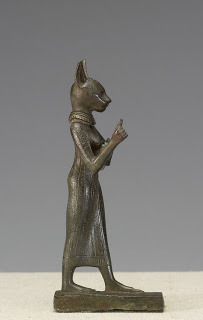 Standing statue representing the Egyptian
Standing statue representing the Egyptiangoddess, Bastet.Noah and the ArkTrivia fact: cats are not mentioned in the bible.
An old Arabian legend does however connect the cat’s creation with the ark. The folk tale reports that the pair of mice taken on board multiplied to plague proportions. With no cat on board and conditions growing intolerable, Noah passed his hand three times over the lioness’s head and she sneezed out a cat.
Monkey and the LionessAnother story about the origins of the cat also involves the ark but also a monkey and a lioness. In this tale the monkey sweet talks the lioness into forgetting her vows of fidelity to her husband, the lion. The result of this transgression of the laws of nature, is the birth of a cat.
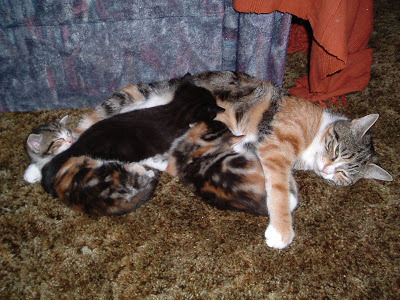 Noni, (one of my cats) and her kittens.Sun and MoonAnother story, recounted in 1664 by Pierre Palliot, writes of the involvement of the planets in the making of cats.
Noni, (one of my cats) and her kittens.Sun and MoonAnother story, recounted in 1664 by Pierre Palliot, writes of the involvement of the planets in the making of cats. At the moment the world came into existence, the Sun and the Moon competed with each other to create animals. The Sun gave birth to the lion – showy, magnificent and fiery. When the moon saw the admiration of the other planets for the lion, she caused the cat to come forth – cool, elusive and mysterious. However, the Sun, jealous of the Moon’s achievement, belittled the Moon who tried to out-do herself by creating the Monkey. This was met with howls of derision from the stars. In a fit of pique, the Moon avenged herself by swearing an undying enmity between the Cat and the Mouse.
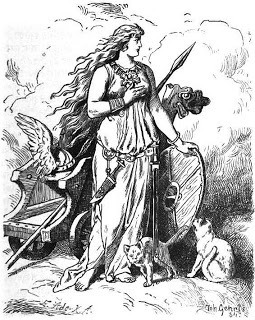 The Norse goddess, Freya.
The Norse goddess, Freya. Her chariot was pulled by cats.And finally: Legends from Egyptian and Norse civilisations link cats with the sun and moon. The Norse goddess Freya rides in a chariot pulled by cats. The Egyptian goddess Pasht represented light, the sun and moon, indeed the Egyptian word ‘mau’ signifies both light and cat.
“The cat laps moonbeams in the bowl of water, thinking them to be milk” A Hindu poem.

Published on June 26, 2013 01:53
June 19, 2013
Cat Law in History
This week I take a quick romp through history and look at the law as it pertains to cats.
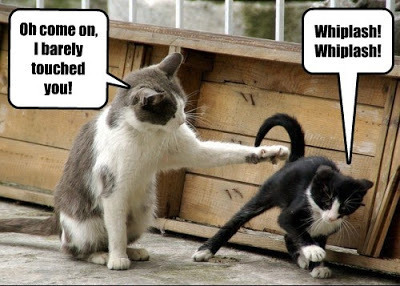
Old English common law states that cats and dogs are:"Not property, being base by nature."
This seems a wise ruling, since in medieval England theft was punishable by hanging; given that cats are apt to wander and chose their own home, if cats are perceived as property householders could easily find themselves on the scaffold through no fault of their own.
Another 'cat' law was the 13th century "Rule of Nuns". This forbade holy women from keeping any animal other than a cat. I find this interestingly ironic given that a couple of centuries later, woman find themselves convicted of witch craft, based largely on that they owned a cat, which was considered - the devil's familiar.
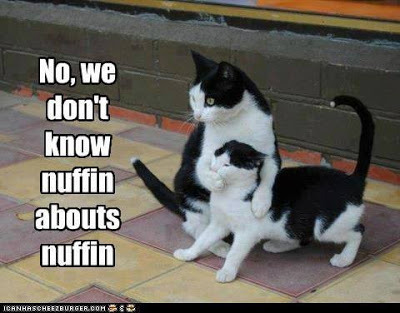 Medieval Welsh laws are quite effusive about cats. The Venedotian Code clearly lays out the value of a cat:
Medieval Welsh laws are quite effusive about cats. The Venedotian Code clearly lays out the value of a cat: The worth of a kitten from the night it is kittened until it shall open its eyes is a legal penny;And from that time until it shall kill mice, two legal pence;And after it shall kill mice, four legal pence; And so it shall always remain.
At that time:One penny -was the value of a lamb or henTwo pence -a cockerel or ganderFour pence -sheep or a goat
In return the qualities or 'job description' of a cat are:To see, to hear, to kill mice, to have her claws entire, to rear kittens…and if she be deficient in any of these qualities, let one third of her worth be returned.
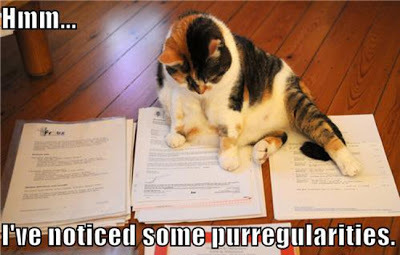
Another early Welsh law, the Dimetian Code describes the compensation due for killing or stealing a cat. This involves suspending the dead cat by the tail with its head on the floor. The corpse is then covered with grain until the tip of the tail is covered - and this amount of corn is the animal's worth - although the practicalities seem fraught with difficulty.
An interesting detail from this code relates to what becomes of the cat if a marriage breaks up. When the husband and wife's goods and chattels are divided, the relatively high worth of a cat is reflected in that:The husband took the cat is there was but oneWith any others [cats] going to the wife.
 When it came to a cat killing creatures it shouldn't - such as a neighbor's birds - the law is a friend of the cat. In Scotland, a late 19th century, an aggrieved plaintiff (who owned the dead pigeon) took the cat's owner to court. The judge concluded:"It was legitimate for the plaintiff to keep a pigeon, but just as much so for the defendant to keep a cat…but there is no obligation for the owner of a cat to restrain it to the house."
When it came to a cat killing creatures it shouldn't - such as a neighbor's birds - the law is a friend of the cat. In Scotland, a late 19th century, an aggrieved plaintiff (who owned the dead pigeon) took the cat's owner to court. The judge concluded:"It was legitimate for the plaintiff to keep a pigeon, but just as much so for the defendant to keep a cat…but there is no obligation for the owner of a cat to restrain it to the house." And finally:Another interesting legal case, this time in Maine, - a plaintiff sued a neighbor for killing a valuable foxhound but was confounded by the defense's argument. The defendant claimed that the dog was chasing his cat, and the law states:"Any person may lawfully kill a dog which …is found worrying, wounding, or killing any domestic animals..."It seems the cat enjoys a protection in law, not afforded to birds!
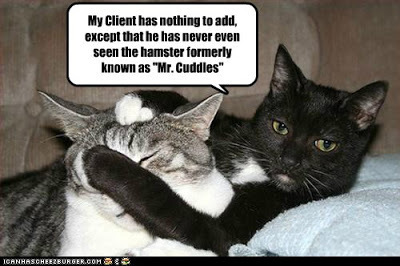
Published on June 19, 2013 02:26
June 12, 2013
Animals in the Dock
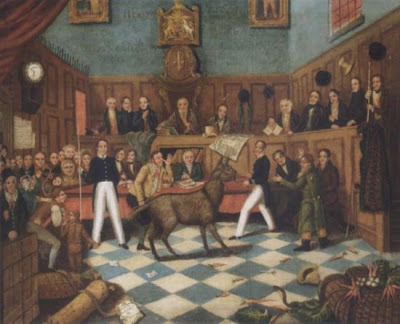 A donkey on trial in a court of law.In this series of blog posts about animal performers, today the focus shifts subtly to animals that were the centre of attention - because they were on trial. This bizarre idea was a result of believing that Satan could possess an animal and the practice reached a peak in ecclesiastical courts during the middle ages. The cases below give some idea of how seriously these trials were taken, with defense and prosecuting lawyers, a jury and a system of acquittal or punishment.
A donkey on trial in a court of law.In this series of blog posts about animal performers, today the focus shifts subtly to animals that were the centre of attention - because they were on trial. This bizarre idea was a result of believing that Satan could possess an animal and the practice reached a peak in ecclesiastical courts during the middle ages. The cases below give some idea of how seriously these trials were taken, with defense and prosecuting lawyers, a jury and a system of acquittal or punishment.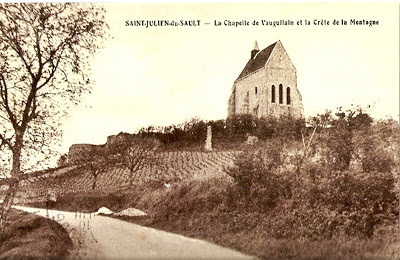 A postcard of the St Julien region of France.Case Number One: WeevilsIn 1587 the vineyards of St Julien, France, were being destroyed by weevils. In response to the demands of wine producers to protect their livelihood, the local authorities put the weevils on trial. Lawyers were employed to prosecute the case, which went something like this:Prosecution:Insects were created before man and their purpose was to serve him as loyal minions. That they were gluttonous meant they were willfully disobeying God's directive and as such should be excommunicated. Defense: The inhabitants of St Julien were sinful and the weevils were innocent messengers, employed by God to demonstrate his displeasure. The Verdict? The debate raged for 8 months. Ultimately a compromise was reached whereby the weevils would be given 'sanctuary' in a field of their own. No comment exists of the practicality of this solution!
A postcard of the St Julien region of France.Case Number One: WeevilsIn 1587 the vineyards of St Julien, France, were being destroyed by weevils. In response to the demands of wine producers to protect their livelihood, the local authorities put the weevils on trial. Lawyers were employed to prosecute the case, which went something like this:Prosecution:Insects were created before man and their purpose was to serve him as loyal minions. That they were gluttonous meant they were willfully disobeying God's directive and as such should be excommunicated. Defense: The inhabitants of St Julien were sinful and the weevils were innocent messengers, employed by God to demonstrate his displeasure. The Verdict? The debate raged for 8 months. Ultimately a compromise was reached whereby the weevils would be given 'sanctuary' in a field of their own. No comment exists of the practicality of this solution! 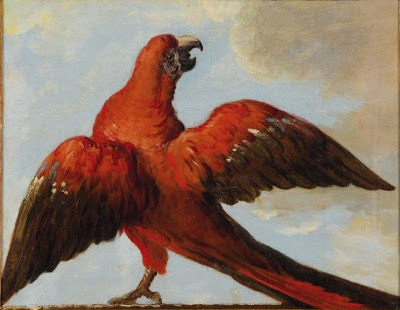 Case Number Two: A Reactionary ParrotThe French revolution was a dangerous time for people, and birds! In Paris, a parrot faced trial for 'counter-revolutionary activities'. In a crowded public place the bird repeated, "Vive le Roi, Vive les nobles" [Long live the King, long live the aristocracy] The bird was duly arrested, along with his two lady owners, and brought before the revolutionary tribunal. Fortunately for the ladies, in the courtroom the bird became taciturn and refused to speak other than to whistle. The women were threatened with the guillotine, but ultimately, were acquitted due to lack of evidence.
Case Number Two: A Reactionary ParrotThe French revolution was a dangerous time for people, and birds! In Paris, a parrot faced trial for 'counter-revolutionary activities'. In a crowded public place the bird repeated, "Vive le Roi, Vive les nobles" [Long live the King, long live the aristocracy] The bird was duly arrested, along with his two lady owners, and brought before the revolutionary tribunal. Fortunately for the ladies, in the courtroom the bird became taciturn and refused to speak other than to whistle. The women were threatened with the guillotine, but ultimately, were acquitted due to lack of evidence. 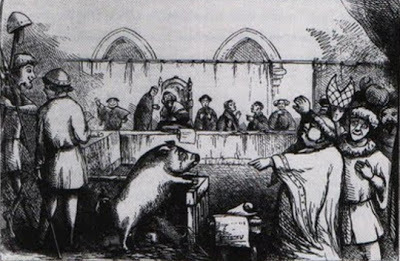 A pig in the dock, on trial.Case Number Three: The Blasphemous PigIn 1394 a sow stood accused of blasphemy. The unfortunate creature had strayed into a church, where she had eaten a communion wafer left out on the altar. Such disrespect could not be tolerated, but when it came to deciding a punishment the priests had a theological problem. When the sow ate the sacred wafer had her flesh transubstantiated into that of Christ's? Eventually, the pig was executed, by which time there was no trace of wafer in her gut - much to everyone's relief.
A pig in the dock, on trial.Case Number Three: The Blasphemous PigIn 1394 a sow stood accused of blasphemy. The unfortunate creature had strayed into a church, where she had eaten a communion wafer left out on the altar. Such disrespect could not be tolerated, but when it came to deciding a punishment the priests had a theological problem. When the sow ate the sacred wafer had her flesh transubstantiated into that of Christ's? Eventually, the pig was executed, by which time there was no trace of wafer in her gut - much to everyone's relief.
 Case Number Four: Mitigating CircumstancesAnimals on trial were so widespread as to be popularized in plays. One such work was Les Plaideurs[The Pleaders] by Jean Racine. In this comedy a dog is put on trial, accused of stealing a chicken. The dog is found guilty and given a life sentence of hard labor on a galley. But the defense lawyer produces a litter of puppies, the 'children' of the accused, and pleads with the judge not to make these innocent creatures homeless orphans. The judge is duly humbled and the dog acquitted.
Case Number Four: Mitigating CircumstancesAnimals on trial were so widespread as to be popularized in plays. One such work was Les Plaideurs[The Pleaders] by Jean Racine. In this comedy a dog is put on trial, accused of stealing a chicken. The dog is found guilty and given a life sentence of hard labor on a galley. But the defense lawyer produces a litter of puppies, the 'children' of the accused, and pleads with the judge not to make these innocent creatures homeless orphans. The judge is duly humbled and the dog acquitted. 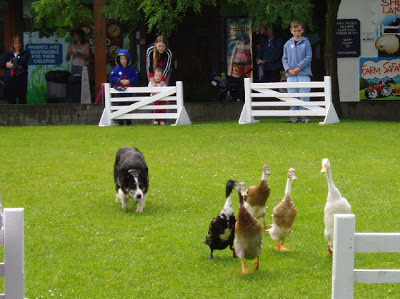 A different sort of dog trial! And finally…The apposing argument to putting animals on trial was that they cannot discriminate good from evil and have no concept of what is a crime, thus punishing them was pointless. In 1717 the Pope forbade the excommunication of animals and few trials took place after this date.
A different sort of dog trial! And finally…The apposing argument to putting animals on trial was that they cannot discriminate good from evil and have no concept of what is a crime, thus punishing them was pointless. In 1717 the Pope forbade the excommunication of animals and few trials took place after this date.
Published on June 12, 2013 02:43
June 3, 2013
Traditional English Food Trivia
Welcome to the Summer Banquet Blog Hop and giveaway (see end for giveaway details)!
The theme of this blog hop is historical food and so I thought it would be fun to look at trivia associated with some traditional, English regional dishes.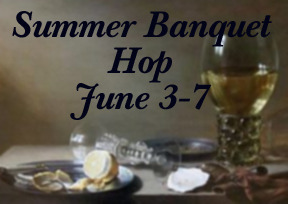
Black Pudding and the Wars of the RosesAs a vegetarian of twenty-five years, I'm bemused to admit that as a child, black pudding was a favourite treat! For the uninitiated, the main ingredient is blood (which gives the black colouration) mixed with a filler to make it solid enough to form into a sausage. In past centuries it was considered a delicacy, especially in Lancashire.
 Black puddingIndeed, the Lancastrian towns of Bury and Ramsbottom still host 'The World Black Pudding Throwing Championships'. The aim is to throw six-ounce black puddings at a pile of Yorkshirepuddings sitting on a 20-foot plinth. This tradition is said to go back to the Wars of the Roses when opposing soldiers ran out of ammunition and threw food at one another.
Black puddingIndeed, the Lancastrian towns of Bury and Ramsbottom still host 'The World Black Pudding Throwing Championships'. The aim is to throw six-ounce black puddings at a pile of Yorkshirepuddings sitting on a 20-foot plinth. This tradition is said to go back to the Wars of the Roses when opposing soldiers ran out of ammunition and threw food at one another.
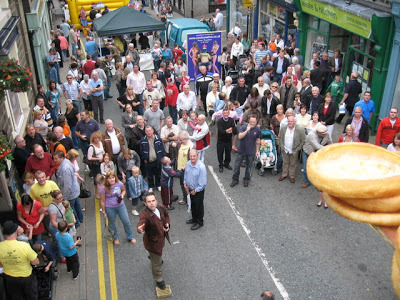 The Black Pudding Throwing Championship
The Black Pudding Throwing Championship
Roast Beef and Beefeaters
When mighty Roast Beef was the Englishman's food,It ennobled our brains and enriched our bloodOut soldiers were brave and our courtiers were goodOh! The Roast Beef of old England,And old English Roast Beef! Henry Fielding, 1731, The Grub Street Opera
Roast beef and the English have become synonymous, and is the reason the French disparagingly call us 'rosbifs'. In Shakespeare's 'Henry V' on the eve of the Battle of Agincourt, the French trembled facing the English because:"…great meals of beef and iron and steel, they will eat like wolves and fight like devils".Such was the reputation of beef that King James I gave his royal bodyguard, the Yeoman of the Guard, extra rations and hence they became known as 'beefeaters'.
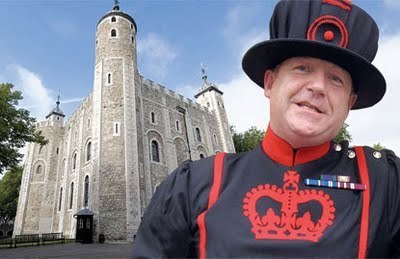 A Yeoman of the Guard, or beefeater - at the Tower of LondonCornish Pasties and the DevilA pasty is an old English term for a pie baked not in a dish. The traditional pasty was a portable meal for tin miners, with a thick pastry edge to hold the pie by, keeping dirty fingers away from the food. The filling would be beef, potato, onion and swede or turnip, and some had a fruit filling at the other end - a sort of two course meal.
A Yeoman of the Guard, or beefeater - at the Tower of LondonCornish Pasties and the DevilA pasty is an old English term for a pie baked not in a dish. The traditional pasty was a portable meal for tin miners, with a thick pastry edge to hold the pie by, keeping dirty fingers away from the food. The filling would be beef, potato, onion and swede or turnip, and some had a fruit filling at the other end - a sort of two course meal.
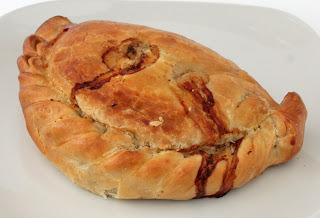 A Cornish pasty According to a Cornish saying, the Devil took care to stay on the Devon bank of the River Tamar [dividing the counties] in case he ended up diced in a pasty.
A Cornish pasty According to a Cornish saying, the Devil took care to stay on the Devon bank of the River Tamar [dividing the counties] in case he ended up diced in a pasty.
 The River TamarGIVEAWAY - details.
The River TamarGIVEAWAY - details.
With the release of Verity's Lie just a couple of weeks away, my giveaway prize are an eBook copy of Eulogy's Secret AND Hope's Betrayal! For a chance to win just enrol for my NEWSLETTER and leave a comment with your email address. Winner announced on June 10th.
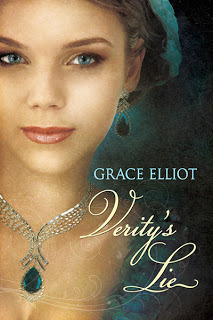 Coming soon!
Coming soon!
Blogs participating in this hop:
Random Bits of Fascination (Maria Grace)Pillings Writing Corner (David Pilling)Anna BelfrageDebra Brown Lauren GilbertGillian BagwellJulie K. RoseDonna Russo MorinRegina JeffersShauna RobertsTinney S. HeathGrace ElliotDiane Scott LewisGinger MyrickHelen HollickHeather DominMargaret SkeaYves FeyJL OakleyShannon WinslowEvangeline HollandCora LeeLaura PurcellP. O. DixonE.M. PowellSharon LathanSally Smith O’RourkeAllison BruningViolet BedfordSue MillardKim Rendfeld
The theme of this blog hop is historical food and so I thought it would be fun to look at trivia associated with some traditional, English regional dishes.

Black Pudding and the Wars of the RosesAs a vegetarian of twenty-five years, I'm bemused to admit that as a child, black pudding was a favourite treat! For the uninitiated, the main ingredient is blood (which gives the black colouration) mixed with a filler to make it solid enough to form into a sausage. In past centuries it was considered a delicacy, especially in Lancashire.
 Black puddingIndeed, the Lancastrian towns of Bury and Ramsbottom still host 'The World Black Pudding Throwing Championships'. The aim is to throw six-ounce black puddings at a pile of Yorkshirepuddings sitting on a 20-foot plinth. This tradition is said to go back to the Wars of the Roses when opposing soldiers ran out of ammunition and threw food at one another.
Black puddingIndeed, the Lancastrian towns of Bury and Ramsbottom still host 'The World Black Pudding Throwing Championships'. The aim is to throw six-ounce black puddings at a pile of Yorkshirepuddings sitting on a 20-foot plinth. This tradition is said to go back to the Wars of the Roses when opposing soldiers ran out of ammunition and threw food at one another.  The Black Pudding Throwing Championship
The Black Pudding Throwing ChampionshipRoast Beef and Beefeaters
When mighty Roast Beef was the Englishman's food,It ennobled our brains and enriched our bloodOut soldiers were brave and our courtiers were goodOh! The Roast Beef of old England,And old English Roast Beef! Henry Fielding, 1731, The Grub Street Opera
Roast beef and the English have become synonymous, and is the reason the French disparagingly call us 'rosbifs'. In Shakespeare's 'Henry V' on the eve of the Battle of Agincourt, the French trembled facing the English because:"…great meals of beef and iron and steel, they will eat like wolves and fight like devils".Such was the reputation of beef that King James I gave his royal bodyguard, the Yeoman of the Guard, extra rations and hence they became known as 'beefeaters'.
 A Yeoman of the Guard, or beefeater - at the Tower of LondonCornish Pasties and the DevilA pasty is an old English term for a pie baked not in a dish. The traditional pasty was a portable meal for tin miners, with a thick pastry edge to hold the pie by, keeping dirty fingers away from the food. The filling would be beef, potato, onion and swede or turnip, and some had a fruit filling at the other end - a sort of two course meal.
A Yeoman of the Guard, or beefeater - at the Tower of LondonCornish Pasties and the DevilA pasty is an old English term for a pie baked not in a dish. The traditional pasty was a portable meal for tin miners, with a thick pastry edge to hold the pie by, keeping dirty fingers away from the food. The filling would be beef, potato, onion and swede or turnip, and some had a fruit filling at the other end - a sort of two course meal. A Cornish pasty According to a Cornish saying, the Devil took care to stay on the Devon bank of the River Tamar [dividing the counties] in case he ended up diced in a pasty.
A Cornish pasty According to a Cornish saying, the Devil took care to stay on the Devon bank of the River Tamar [dividing the counties] in case he ended up diced in a pasty.  The River TamarGIVEAWAY - details.
The River TamarGIVEAWAY - details. With the release of Verity's Lie just a couple of weeks away, my giveaway prize are an eBook copy of Eulogy's Secret AND Hope's Betrayal! For a chance to win just enrol for my NEWSLETTER and leave a comment with your email address. Winner announced on June 10th.
 Coming soon!
Coming soon!Blogs participating in this hop:
Random Bits of Fascination (Maria Grace)Pillings Writing Corner (David Pilling)Anna BelfrageDebra Brown Lauren GilbertGillian BagwellJulie K. RoseDonna Russo MorinRegina JeffersShauna RobertsTinney S. HeathGrace ElliotDiane Scott LewisGinger MyrickHelen HollickHeather DominMargaret SkeaYves FeyJL OakleyShannon WinslowEvangeline HollandCora LeeLaura PurcellP. O. DixonE.M. PowellSharon LathanSally Smith O’RourkeAllison BruningViolet BedfordSue MillardKim Rendfeld
Published on June 03, 2013 00:30
'Familiar Felines.'
Following on from last weeks Halloween posting, today's blog post looks at the unwanted image of cats as the witches familiar - from the Norse Goddess Freya to lonely women in the middle ages.
The full Following on from last weeks Halloween posting, today's blog post looks at the unwanted image of cats as the witches familiar - from the Norse Goddess Freya to lonely women in the middle ages.
The full post can found at:
http://graceelliot-author.blogspot.com
...more
The full Following on from last weeks Halloween posting, today's blog post looks at the unwanted image of cats as the witches familiar - from the Norse Goddess Freya to lonely women in the middle ages.
The full post can found at:
http://graceelliot-author.blogspot.com
...more
- Grace Elliot's profile
- 156 followers



